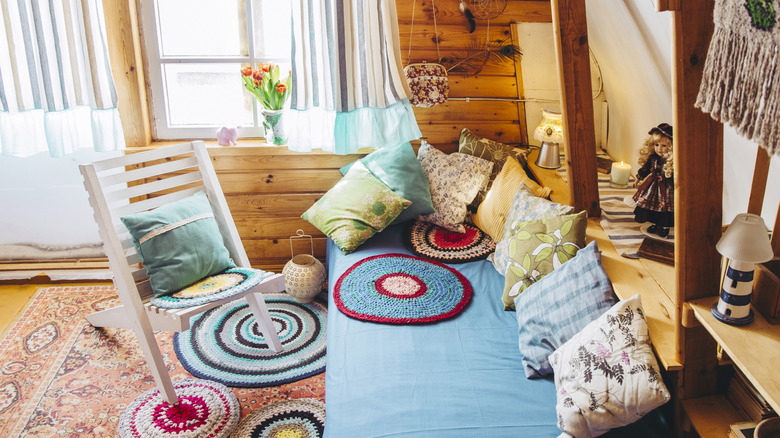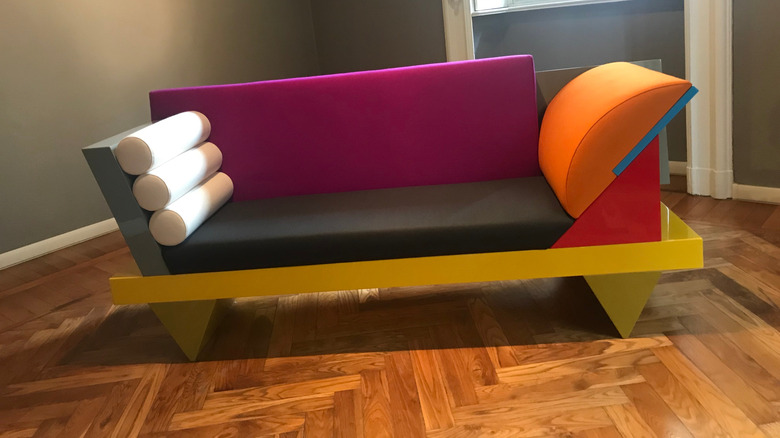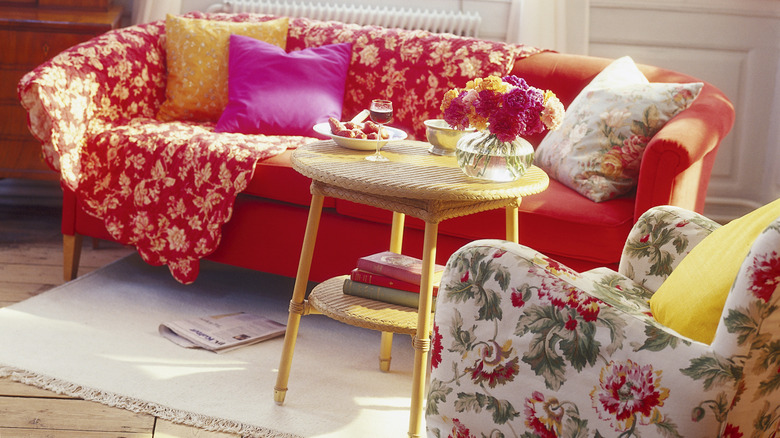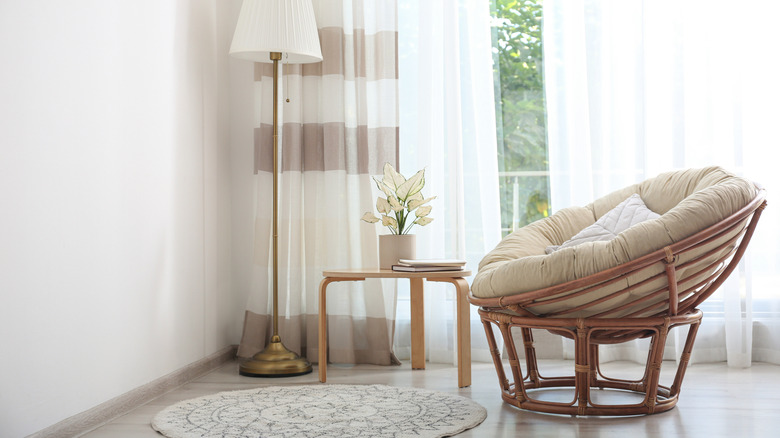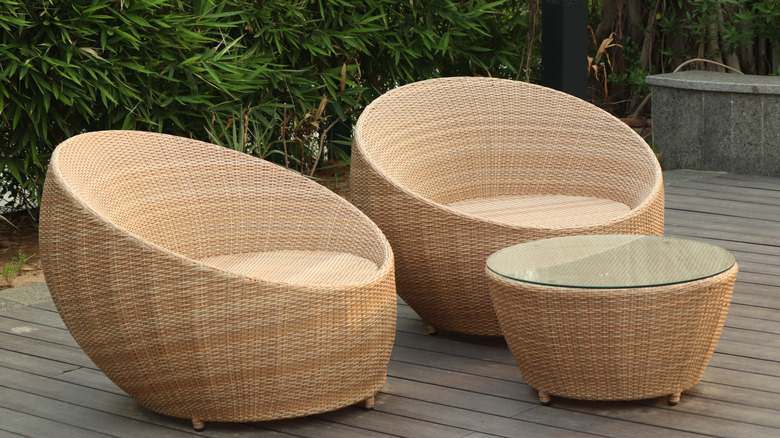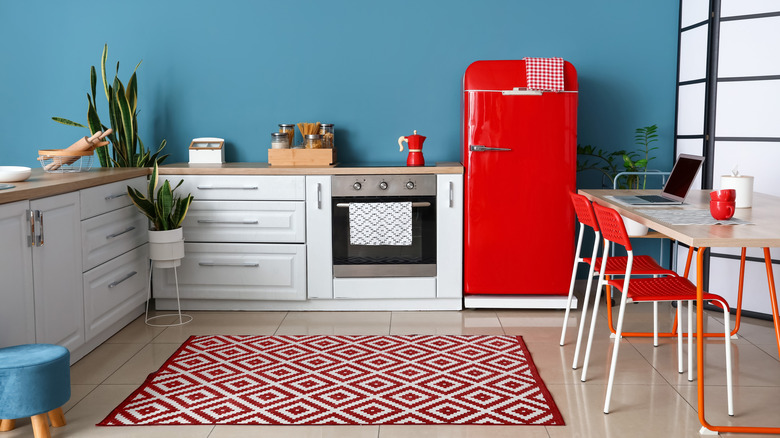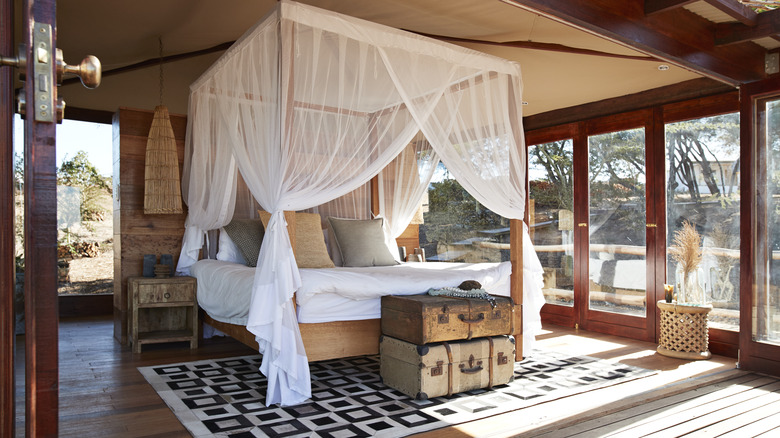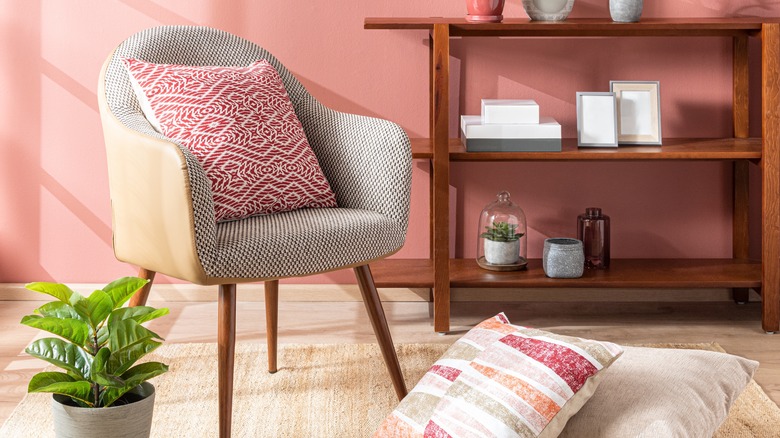8 Unexpected Furniture Trends That Are Coming Back In Style
We may receive a commission on purchases made from links.
Are you still clutching your cream throw blankets, waxing poetic about minimalism and the "less is more" approach? Or, perhaps, you're still chiding your grandma for keeping her floral sofa, calling it a horrid design crime whose traces must be swept clean. Well, looks like you're running behind on the latest furniture trends, for the interior design world has had a change of heart. Currently, the "less is indeed less" mentality is doing the rounds and isn't likely to go anywhere soon. Simply put, maximalism, with all its fervent drama, floral prints, and canopy beds, is making its way back into the furniture design circles.
So, designers are going all out but keeping things cozy, inviting, and approachable. For instance, modern homes are being styled in breathy linen fabrics, while the more exuberant homes are getting on the country club vibe. Conversely, others are giving in to their brassy tendencies, showing off colorful appliances or Memphis-style furnishings. So, to ensure you don't miss out on the retro furniture trends making a comeback, here's an exclusive scoop from Sarah Bilotta, House Digest's in-house design expert and board member for the Journal of Design History.
Post-modernist Memphis group-style furnishings promise a colorful, eclectic look
"Succession" might have spurred the wave of quiet luxury with its sleek lines and muted tones, but there is an echelon that'd rather keep things eccentrically arresting with color. "In 2024, we began to see Gen Z embrace the 1990s through color blocking and bright, surprising geometric furnishings in unexpected shapes," says Bilotta. Post-modernist Memphis design, with its art deco colors and jarring geometric designs, just hit the right notes, winning itself a poetic resurgence. Those who weren't completely onboard were won over with kitsch styles and mish-mashed humble materials (imagine combining MDF with terrazzo).
The best part of this comeback is that you don't have to hunt for a high-end antique dealer or sit through auctions to acquire spirited furnishings. Instead, you can snag them off online marketplaces. "Bright and playful furnishings like those produced by Italy's famous Memphis Design Group are now available on Wayfair and Amazon," elaborates Bilotta. However, this still begs the question: Why is Gen Z embracing color? "The statement-making pieces are to Gen Z what midcentury modern is to millennials: a bit of nostalgia in a chic package." In a way, they're a symbolic rejection of the stark, all-white contemporary look that dominated homes in the 2010s, just as the Memphis movement was to modernism's functionality. Besides, "These pops of color pair fantastically against the deep, saturated paint tones also becoming popular," adds Bilotta.
Maximalists have brought back floral upholstery into their interiors
Spend a decent time on TikTok and odds are you have come across the "grandma chic" trend, exhorting a mix of coziness (because grandma, duh!) and ornate furniture (all those sculptured vases and candlesticks). However, it also brought back the trend of floral patterns, in a nostalgic callout to maximalism — and your childhood. "You either love it or hate it, but the cottagecore decor trend of the early 2020s brought floral upholstery back into the design sourcebook of 2024," says Bilotta. "Country retreats and cottages were adorned with plush wingback chairs and ruffly tufted sofas bedecked with flowers." That wasn't all, as anything and everything, from mosaic floor tiles to peel-and-stick wallpapers, had patterns. Dramatic blooms, bold petals, or delicate buds (bonus points if it was toile) all had a chance to shine. "We went big with patterns this year, and we weren't afraid to be a bit kitschy."
However, Bilotta admits it's a mixed bag. "While some aspects of cottagecore are already starting to fade from popularity (no one wants to dust all those knick-knacks), the cozy kitsch of floral upholstery doesn't seem to be going anywhere." And the reasons make intuitive sense. "As we struggle through an era of political change, many of us will take refuge in cozifying our space," she notes. Frankly, when it comes to feeling snug and comfy, evoking grandma's décor remains unbeaten.
Papasan chairs are back in style, but with a twist
Your world history book probably failed to note it, but Bilotta highlights, "The papasan chair came to the United States in the trunks of soldiers returning from the Pacific front of World War II." This sort of kickstarted a "military chic" trend, where every home had a bowl-shaped, rattan-based frame topped by a straight-colored cushion for lazing about or crocheting. Soon, this trend made it into the 1970s hippie culture and then re-emerged in the 2000s as a cozy living room seating idea that is off the beaten path. College dorms weren't untouched by Papasan chairs either — you might remember them as saucer or moon chairs — since they were the perfect place to crash after parties. "For the past 15 years or so, they've remained a staple in households that love them," adds Bilotta, "though many have rejected them for a simple reason: they're large and can only seat one person."
So, what's fueled the bowl chair's comeback? Perhaps the urge to birdwatch, sunbath, or enjoy nature while being rocked to sleep in a moving chair. Bilotta explains, "The papasan rocking chair went viral on TikTok, and it's not slowing down." Apparently, "TikTokers started incorporating them into their patio decor, moving these giant space-wasters to otherwise unoccupied space." They are also propped on decks or in the room's reading nook. The good news? "These chairs are available from a number of manufacturers and can be easily purchased on Amazon," such as this one from Colamy that comes in multiple colors.
Cane furniture is on its way to becoming a timeless favorite
Cane furniture entered the scene with all guns blazing in the 2020s and was immediately matched to diverse interior designs, from Bohemian to mid-century. It felt natural since it came from plant fibers, and sensory because of the sophisticated weaving. "Extremely popular since the beginning of the 2020s, this trend shows no signs of slowing down. I believe it will hit its peak in 2025, with cane chairs, bed headboards, and even side tables and coffee tables in cane available everywhere," says Bilotta. "It's a very natural-looking material that does not attempt to hide what it is." Simply put, unlike other furniture, say the closely related rattan, that is often painted over or draped with throws to make it more agreeable, cane furniture is embedded into designs as is. "It's also a representation of how a natural material can be transformed without being disguised."
Elaborating on her reasons for cane furniture remaining in style, Bilotta mentions that since eco-activism is surging, the appreciation for natural materials and intricate craftsmanship is growing among furniture collectors. It doesn't matter if they're pressed or pre-woven by machine. "Whether hand-caned or fabricated in a factory, caning is a centuries-old technique which is still much-loved." And that's reason enough to go the "cane everything" route.
Color is coming for your stainless-steel finishes
Not too long ago, nearly 50% voted for stainless steel for their favorite finish for kitchen appliances in a House Digest survey. Indeed, so ubiquitous is this finish that when supply chains remained blocked in the aftermath of COVID-19, manufacturers redirected all their resources into creating stainless steel appliances. Fast forward to 2024, and it appears most homeowners have had their fill of stainless steel, choosing instead to make space for color. Bilotta clarifies, "In the early 2020s, we began to see a proliferation of enamel ovens in charming colors, particularly a resurgence in the affinity for brands known for their colorful kitchen appliances like Aga and Smeg." Smeg, in particular, is renowned for its diverse lines, invoking the Mediterranean aesthetic with its Portofino collection or going all whimsical with its Retro Style collection. In contrast, Aga adds a more contemporary touch to kitchen interiors, often serving as a focal point thanks to its statement colors.
Apart from ovens, Bilotta also notes the supersession of stainless steel finishes for color in enamel refrigerators and dishwashers. For instance, ZLINE'S compact dishwasher with hammered copper handles is becoming exceedingly popular. "Warm metals like brass and bronze are finding their way into everything from refrigerators to lamps, while colorful plastic and enamel appliances are taking over retro-inspired kitchens," she adds. Seemingly, "Just like the all-white-walls trend of the early 2000s, stainless steel appliances are now thought of as cold and lacking personality," driving their downfall.
Canopy beds are all set to reclaim your bedrooms... again
You'd think with period dramas like "The Crown," "Bridgerton," or "Queen Charlotte" constantly rubbing their opulence in our faces, the trend of canopy beds would never feel dated — and that's somewhat true. After all, they promise luxury, privacy, romance, and draft protection in a poorly insulated home. However, the interior designing world works differently, focusing on one aspect in ignorance of others, creating a wave of trends. Bilotta elaborates, "Although the 2000s and 2010s saw an uptick in feature headboards (from tufted to wood paneled), there's another rising trend that could supersede headboards in 2025: canopy beds. They have been around for centuries, and they come and go in the interior design lexicon, but lately, they are 'in' again." It's worth nothing that your ceiling must be at least 9 feet high to fit the tall bed.
Since 2025 is already bringing in the drama with maximalist wallpapers and saturated paint colors, Bilotta believes canopy beds have every reason to piggyback on this trend. Besides, there is no dearth of gorgeous ways to style a canopy bed to fit your aesthetic. "You can drape them with curtains for some extra privacy or leave them bare, like an airy, dramatic cage that exaggerates the size of your bed." However, she cautions, "While they can be stripped bare for a more minimal look, the use of vertical space over your bed is always dramatic."
Linen fabrics are returning as living room upholstery
Linen is the once-trendy fabric that's making its way back into home decor, according to our in-house expert. "While heavy boucles and velvets will remain timelessly popular, there has been an uptick in the use of light, earthy textured upholstery fabrics for sofas and armchairs — linen in particular." Made from flax fibers, linen offers high durability (that cotton can't match) and grows softer with use, playing into the cozy aesthetic. "From beach houses to country cabins, this airy textured fabric brings some dimension and depth to a space without feeling heavy or dramatic," adds Bilotta. In other words, as long as you stick to neutral shades, upholstering with linen can ensure your décor remains fresh and timeless.
But why bother with linen at all? To satiate the itch for newness. "It's always tempting to bring some texture to your seating with a dense, plush fabric — but boucles have dominated for the last few years, and we see designers craving alternate ways of incorporating texture into a sitting room." This creates the window for linen upholstery, especially on the sofa and chairs, as it makes room for textural play without turning them into the loudest pieces in your living area. While Bilotta acknowledges that it's easy to associate linen with the wrinkly summer slipcover on your grandma's sofa, she insists that linen upholstery works differently and is worth a go. But avoid this trend if you've got furry friends with an itch to scratch.
Club aesthetic is set to make waves anew
If club aesthetic has you thinking about your night escapades with friends, stop right in your tracks. This trend has nothing to do with trance or techno music. Instead, "Timeless and masculine, 'club'-inspired furniture dates to the private gentlemen's members clubs of Pall Mall, London, back in the 17th and 18th centuries," explains Bilotta. "Think tufted leather armchairs, fine mahogany card tables, and bulky 'executive' desks for doing manly things." Basically, your interior design will veer towards antiquity (and male brooding), involving the interplay of rich, dark wood tones in furniture and floors, teamed with classical adornments, especially gold and brass hardware. However, despite the deeper hues, the interiors are supposed to remain functional, approachable, and laidback.
Essentially, Bilotta says, "Surges in the popularity of this style tend to accompany a parallel surge in more feminine furnishings, like the floral upholstery and ruffled drapes typical of the cottagecore look." Fortunately, both design styles can bring about an aristocratic harmony. This is similar to the Ralph Lauren aesthetic that often combines plaid patterns and earthy furniture with florescent prints that soften the manly vibes. Bilotta exemplifies her choice of club aesthetic, too, maintaining a rich floral carpet would team delightfully well with a whiskey-colored leather club chair.
